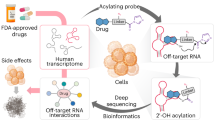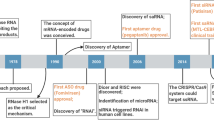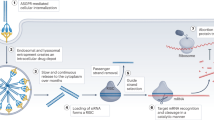Abstract
The rapid identification of highly specific and potent drug candidates continues to be a substantial challenge with traditional pharmaceutical approaches. Moreover, many targets have proven to be intractable to traditional small-molecule and protein approaches. Therapeutics based on RNA interference (RNAi) offer a powerful method for rapidly identifying specific and potent inhibitors of disease targets from all molecular classes. Numerous proof-of-concept studies in animal models of human disease demonstrate the broad potential application of RNAi therapeutics. The major challenge for successful drug development is identifying delivery strategies that can be translated to the clinic. With advances in this area and the commencement of multiple clinical trials with RNAi therapeutic candidates, a transformation in modern medicine may soon be realized.
This is a preview of subscription content, access via your institution
Access options
Subscribe to this journal
Receive 12 print issues and online access
$259.00 per year
only $21.58 per issue
Buy this article
- Purchase on SpringerLink
- Instant access to full article PDF
Prices may be subject to local taxes which are calculated during checkout




Similar content being viewed by others
References
Dykxhoorn, D.M., Palliser, D. & Lieberman, J. The silent treatment: siRNAs as small molecule drugs. Gene Ther. 13, 541–552 (2006).
Dykxhoorn, D.M. & Lieberman, J. Running interference: prospects and obstacles to using small interfering RNAs as small molecule drugs. Annu. Rev. Biomed. Eng. 8, 377–402 (2006).
Rand, T.A., Ginalski, K., Grishin, N.V. & Wang, X. Biochemical identification of Argonaute 2 as the sole protein required for RNA-induced silencing complex activity. Proc. Natl. Acad. Sci. USA 101, 14385–14389 (2004).
Ma, J.B. et al. Structural basis for 5′-end-specific recognition of guide RNA by the A. fulgidus Piwi protein. Nature 434, 666–670 (2005).
Matranga, C., Tomari, Y., Shin, C., Bartel, D.P. & Zamore, P.D. Passenger-strand cleavage facilitates assembly of siRNA into Ago2-containing RNAi enzyme complexes. Cell 123, 607–620 (2005).
Rand, T.A., Petersen, S., Du, F. & Wang, X. Argonaute2 cleaves the anti-guide strand of siRNA during RISC activation. Cell 123, 621–629 (2005).
Soutschek, J. et al. Therapeutic silencing of an endogenous gene by systemic administration of modified siRNAs. Nature 432, 173–178 (2004).
Vornlocher, H.P., Zimmermann, T.S., Manoharan, M., Rajeev, KG., Roehl, I. & Akinc, A. Nuclease-resistant double-stranded RNA for RNA interference. Patent Cooperation Treaty International Application WO2005115481 (2005).
Li, B. et al. Using siRNA in prophylactic and therapeutic regimens against SARS coronavirus in Rhesus macaque. Nat. Med. 11, 944–951 (2005).
Choung, S., Kim, Y.J., Kim, S., Park, H.O. & Choi, Y.C. Chemical modification of siRNAs to improve serum stability without loss of efficacy. Biochem. Biophys. Res. Commun. 342, 919–927 (2006).
Allerson, C.R. et al. Fully 2'-modified oligonucleotide duplexes with improved in vitro potency and stability compared to unmodified small interfering RNA. J. Med. Chem. 48, 901–904 (2005).
Prakash, T.P. et al. Positional effect of chemical modifications on short interference RNA activity in mammalian cells. J. Med. Chem. 48, 4247–4253 (2005).
Hoshika, S., Minakawa, N. & Matsuda, A. Synthesis and physical and physiological properties of 4'-thioRNA: application to post-modification of RNA aptamer toward NF-κB. Nucleic Acids Res. 32, 3815–3825 (2004).
Haeberli, P., Berger, I., Pallan, P.S. & Egli, M. Syntheses of 4'-thioribonucleosides and thermodynamic stability and crystal structure of RNA oligomers with incorporated 4'-thiocytosine. Nucleic Acids Res. 33, 3965–3975 (2005).
Dande, P. et al. Improving RNA interference in mammalian cells by 4'-thio-modified small interfering RNA (siRNA): effect on siRNA activity and nuclease stability when used in combination with 2'-O-alkyl modifications. J. Med. Chem. 49, 1624–1634 (2006).
Prakash, T.P. et al. RNA interference by 2′,5′- linked nucleic acid duplexes in mammalian cells. Bioorg. Med. Chem. Lett. 16, 3238–3240 (2006).
Hall, A.H., Wan, J., Shaughnessy, E.E., Ramsay Shaw, B. & Alexander, K.A. RNA interference using boranophosphate siRNAs: structure-activity relationships. Nucleic Acids Res. 32, 5991–6000 (2004).
Hall, A.H. et al. High potency silencing by single-stranded boranophosphate siRNA. Nucleic Acids Res. 34, 2773–2781 (2006).
Xia, J. et al. Gene silencing activity of siRNAs with a ribo-difluorotoluyl nucleotide. ACS Chem. Biol. 1, 176–183 (2006).
Somoza, A., Chelliserrykattil, J. & Kool, E.T. The roles of hydrogen bonding and sterics in RNA interference. Angew. Chem. Int. Edn. Engl. 45, 4994–4997 (2006).
Elbashir, S.M. et al. Duplexes of 21-nucleotide RNAs mediate RNA interference in cultured mammalian cells. Nature 411, 494–498 (2001).
Elbashir, S.M., Lendeckel, W. & Tuschl, T. RNA interference is mediated by 21- and 22-nucleotide RNAs. Genes Dev. 15, 188–200 (2001).
Boese, Q. et al. Mechanistic insights aid computational short interfering RNA design. Methods Enzymol. 392, 73–96 (2005).
Yuan, B., Latek, R., Hossbach, M., Tuschl, T. & Lewitter, F. siRNA Selection Server: an automated siRNA oligonucleotide prediction server. Nucleic Acids Res. 32, W130–W134 (2004).
Schwarz, D.S. et al. Asymmetry in the assembly of the RNAi enzyme complex. Cell 115, 199–208 (2003).
Khvorova, A., Reynolds, A. & Jayasena, S.D. Functional siRNAs and miRNAs exhibit strand bias. Cell 115, 209–216 (2003).
Reynolds, A. et al. Rational siRNA design for RNA interference. Nat. Biotechnol. 22, 326–330 (2004).
Jackson, A.L. et al. Expression profiling reveals off-target gene regulation by RNAi. Nat. Biotechnol. 21, 635–637 (2003).
Lin, X. et al. siRNA-mediated off-target gene silencing triggered by a 7 nt complementation. Nucleic Acids Res. 33, 4527–4535 (2005).
Qiu, S., Adema, C.M. & Lane, T. A computational study of off-target effects of RNA interference. Nucleic Acids Res. 33, 1834–1847 (2005).
Jackson, A.L. et al. Widespread siRNA “off-target” transcript silencing mediated by seed region sequence complementarity. RNA 12, 1179–1187 (2006).
Birmingham, A. et al. 3′ UTR seed matches, but not overall identity, are associated with RNAi off-targets. Nat. Methods 3, 199–204 (2006).
Lewis, B.P., Burge, C.B. & Bartel, D.P. Conserved seed pairing, often flanked by adenosines, indicates that thousands of human genes are microRNA targets. Cell 120, 15–20 (2005).
Jackson, A.L. et al. Position-specific chemical modification of siRNAs reduces “off-target” transcript silencing. RNA 12, 1197–1205 (2006).
Schwarz, D.S. et al. Designing siRNA that distinguish between genes that differ by a single nucleotide. PLoS Genetics (in the press).
Hornung, V. et al. Sequence-specific potent induction of IFN-α by short interfering RNA in plasmacytoid dendritic cells through TLR7. Nat. Med. 11, 263–270 (2005).
Boggs, R.T. et al. Characterization and modulation of immune stimulation by modified oligonucleotides. Antisense Nucleic Acid Drug Dev. 7, 461–471 (1997).
Hemmi, H. et al. A Toll-like receptor recognizes bacterial DNA. Nature 408, 740–745 (2000).
Judge, A.D. et al. Sequence-dependent stimulation of the mammalian innate immune response by synthetic siRNA. Nat. Biotechnol. 23, 457–462 (2005).
Fedorov, Y. et al. Different delivery methods—different expression profiles. Nat. Methods 2, 241 (2005).
Reynolds, A. et al. Induction of the interferon response by siRNA is cell type- and duplex length-dependent. RNA 12, 988–993 (2006).
Bitko, V., Musiyenko, A., Shulyayeva, O. & Barik, S. Inhibition of respiratory viruses by nasally administered siRNA. Nat. Med. 11, 50–55 (2005).
Palliser, D. et al. An siRNA-based microbicide protects mice from lethal herpes simplex virus 2 infection. Nature 439, 89–94 (2005).
Shen, J. et al. Suppression of ocular neovascularization with siRNA targeting VEGF receptor 1. Gene Ther. 13, 225–234 (2006).
Reich, S.J. et al. Small interfering RNA (siRNA) targeting VEGF effectively inhibits ocular neovascularization in a mouse model. Mol. Vis. 9, 210–216 (2003).
Nakamura, H. et al. RNA interference targeting transforming growth factor-beta type II receptor suppresses ocular inflammation and fibrosis. Mol. Vis. 10, 703–711 (2004).
Makimura, H., Mizuno, T.M., Mastaitis, J.W., Agami, R. & Mobbs, C.V. Reducing hypothalamic AGRP by RNA interference increases metabolic rate and decreases body weight without influencing food intake. BMC Neurosci. 3, 18 (2002).
Thakker, D.R. et al. Neurochemical and behavioral consequences of widespread gene knockdown in the adult mouse brain by using nonviral RNA interference. Proc. Natl. Acad. Sci. USA 101, 17270–17275 (2004).
Thakker, D.R. et al. siRNA-mediated knockdown of the serotonin transporter in the adult mouse brain. Mol. Psychiatry 10, 782–789, 714 (2005).
Dorn, G. et al. siRNA relieves chronic neuropathic pain. Nucleic Acids Res. 32, e49 (2004).
Tan, P.H., Yang, L.C., Shih, H.C., Lan, K.C. & Cheng, J.T. Gene knockdown with intrathecal siRNA of NMDA receptor NR2B subunit reduces formalin-induced nociception in the rat. Gene Ther. 12, 59–66 (2005).
Luo, M.C. et al. An efficient intrathecal delivery of small interfering RNA to the spinal cord and peripheral neurons. Mol. Pain 1, 29 (2005).
Salahpour, A., Medvedev, I.O., Beaulieu, J.-M., Gainedinov, R.R. & Caron, M.G. Local knockdown of genes in the brain using small interfering RNA: a phenotypic comparison with knockout animals. Biol. Psychiatry, published online 17 May 2006.
Kumar, P., Lee, S.K., Shankar, P. & Manjunath, N. A single siRNA suppresses fatal encephalitis induced by two different flaviviruses. PLoS Med. 3, e96 (2006).
Chen, Y. et al. Adenovirus-mediated small-interference RNA for in vivo silencing of angiotensin AT1a receptors in mouse brain. Hypertension 47, 230–237 (2006).
Xia, H. et al. RNAi suppresses polyglutamine-induced neurodegeneration in a model of spinocerebellar ataxia. Nat. Med. 10, 816–820 (2004).
Harper, S.Q. et al. RNA interference improves motor and neuropathological abnormalities in a Huntington's disease mouse model. Proc. Natl. Acad. Sci. USA 102, 5820–5825 (2005).
Rodriguez-Lebron, E., Denovan-Wright, E.M., Nash, K., Lewin, A.S. & Mandel, R.J. Intrastriatal rAAV-mediated delivery of anti-huntingtin shRNAs induces partial reversal of disease progression in R6/1 Huntington's disease transgenic mice. Mol. Ther. 12, 618–633 (2005).
Ralph, G.S. et al. Silencing mutant SOD1 using RNAi protects against neurodegeneration and extends survival in an ALS model. Nat. Med. 11, 429–433 (2005).
Raoul, C. et al. Lentiviral-mediated silencing of SOD1 through RNA interference retards disease onset and progression in a mouse model of ALS. Nat. Med. 11, 423–428 (2005).
Singer, O. et al. Targeting BACE1 with siRNAs ameliorates Alzheimer disease neuropathology in a transgenic model. Nat. Neurosci. 8, 1343–1349 (2005).
Niu, X.Y., Peng, Z.L., Duan, W.Q., Wang, H. & Wang, P. Inhibition of HPV 16 E6 oncogene expression by RNA interference in vitro and in vivo. Int. J. Gynecol. Cancer 16, 743–751 (2006).
Grzelinski, M. et al. RNA interference-mediated gene silencing of pleiotrophin through polyethylenimine-complexed small interfering RNAs in vivo exerts antitumoral effects in glioblastoma xenografts. Hum. Gene Ther. 17, 751–766 (2006).
Kim, W.J. et al. Cholesteryl oligoarginine delivering vascular endothelial growth factor siRNA effectively inhibits tumor growth in colon adenocarcinoma. Mol. Ther. 14, 343–350 (2006).
Song, E. et al. Antibody-mediated in vivo delivery of small interfering RNAs via cell-surface receptors. Nat. Biotechnol. 23, 709–717 (2005).
Takei, Y., Kadomatsu, K., Yuzawa, Y., Matsuo, S. & Muramatsu, T. A small interfering RNA targeting vascular endothelial growth factor as cancer therapeutics. Cancer Res. 64, 3365–3370 (2004).
Minakuchi, Y. et al. Atelocollagen-mediated synthetic small interfering RNA delivery for effective gene silencing in vitro and in vivo. Nucleic Acids Res. 32, e109 (2004).
McNamara, J.O. et al. Cell type–specific delivery of siRNAs with aptamer-siRNA chimeras. Nat. Biotechnol. 24, 1005–1015 (2006).
Gurzov, E.N. & Izquierdo, M. RNA interference against Hec1 inhibits tumor growth in vivo. Gene Ther. 13, 1–7 (2005).
Pulukuri, S.M. et al. RNA interference-directed knockdown of urokinase plasminogen activator and urokinase plasminogen activator receptor inhibits prostate cancer cell invasion, survival, and tumorigenicity in vivo. J. Biol. Chem. 280, 36529–36540 (2005).
Zhang, Y. et al. Engineering mucosal RNA interference in vivo. Mol. Ther. 14, 336–342 (2006).
Shankar, P., Manjunath, N. & Lieberman, J. The prospect of silencing disease using RNA interference. J. Am. Med. Assoc. 293, 1367–1373 (2005).
Zimmermann, T.S. et al. RNAi-mediated gene silencing in non-human primates. Nature 441, 111–114 (2006).
Morrissey, D.V. et al. Activity of stabilized short interfering RNA in a mouse model of hepatitis B virus replication. Hepatology 41, 1349–1356 (2005).
Geisbert, T.W. et al. Postexposure protection of guinea pigs against a lethal ebola virus challenge is conferred by RNA interference. J. Infect. Dis. 193, 1650–1657 (2006).
Takeshita, F. & Ochiya, T. Therapeutic potential of RNA interference against cancer. Cancer Sci. 97, 689–696 (2006).
Pal, A. et al. Systemic delivery of RafsiRNA using cationic cardiolipin liposomes silences Raf-1 expression and inhibits tumor growth in xenograft model of human prostate cancer. Int. J. Oncol. 26, 1087–1091 (2005).
Schiffelers, R.M. et al. Cancer siRNA therapy by tumor selective delivery with ligand-targeted sterically stabilized nanoparticle. Nucleic Acids Res. 32, e149 (2004).
Urban-Klein, B., Werth, S., Abuharbeid, S., Czubayko, F. & Aigner, A. RNAi-mediated gene-targeting through systemic application of polyethylenimine (PEI)-complexed siRNA in vivo. Gene Ther. 12, 461–466 (2005).
Hu-Lieskovan, S., Heidel, J.D., Bartlett, D.W., Davis, M.E. & Triche, T.J. Sequence-specific knockdown of EWS-FLI1 by targeted, nonviral delivery of small interfering RNA inhibits tumor growth in a murine model of metastic Ewing's sarcoma. Cancer Res. 65, 8984–8992 (2005).
Grimm, D. et al. Fatality in mice due to oversaturation of cellular microRNA/short hairpin RNA pathways. Nature 441, 537–541 (2006).
Fire, A. et al. Potent and specific genetic interference by double-stranded RNA in Caenorhabditis elegans. Nature 391, 806–811 (1998).
Acknowledgements
We thank J. Maraganore and B. Greene for critical reading of the manuscript, M. Duckman for graphics assistance and A. Capobianco for word processing assistance.
Author information
Authors and Affiliations
Corresponding author
Ethics declarations
Competing interests
The authors are employees of Alnylam Pharmaceuticals.
Rights and permissions
About this article
Cite this article
Bumcrot, D., Manoharan, M., Koteliansky, V. et al. RNAi therapeutics: a potential new class of pharmaceutical drugs. Nat Chem Biol 2, 711–719 (2006). https://doi.org/10.1038/nchembio839
Issue date:
DOI: https://doi.org/10.1038/nchembio839
This article is cited by
-
Nanoparticle-based theranostics in nuclear medicine
Journal of Radioanalytical and Nuclear Chemistry (2024)
-
Small interfering RNA (siRNA)-based therapeutic applications against viruses: principles, potential, and challenges
Journal of Biomedical Science (2023)
-
Endogenous dual miRNA-triggered dynamic assembly of DNA nanostructures for in-situ dual siRNA delivery
Science China Materials (2023)
-
ApoE—functionalization of nanoparticles for targeted brain delivery—a feasible method for polyplexes?
Drug Delivery and Translational Research (2023)
-
Visualization of the process of a nanocarrier-mediated gene delivery: stabilization, endocytosis and endosomal escape of genes for intracellular spreading
Journal of Nanobiotechnology (2022)



